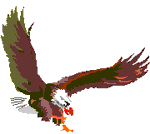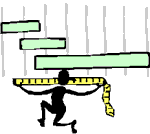

Info 3: Scaling Flying Beings

Have you looked at the birds in the sky and wondered how they can fly so gracefully? Why are small birds experts at aerobatics while large birds almost look clumsy? Why are large birds able to hover without moving their wings while small birds have to vigorously use their wings in order not to move? Is all this just a coincidence, or are there deeper reasons for these differences?
Flying observations
For eons, birds of prey have, via trial and error, developed excellent skills for locating pray. Often, this involves remaining afloat without moving relative the ground (hovering). In mastering this technique, natural selection has shaped these large birds into their current forms.
Rarely does a bird of prey actually manage to catch a smaller, flying bird. Small birds stay alive partly due to their well-developed ability to rapidly change their direction of flying. Is the difference in size just a coincidence, or is size important when flying?

The bumblebee is said to be unaware of that it should not be able to fly, according to the 'simpler' aerodynamic theories that successfully explains why birds and aircrafts can fly. Fortunate for the bumblebee, advanced aerodynamic simulations reveal that its fluttering of the wings creates an air-pocket between its wings with sufficiently low pressure to lift it. This illustrates that the relative importance of physical phenomena is size-dependent.
Inertia
Experience shows that macroscopic physical laws are valid also in the micro-world, provided the dimensions are large compared with atomic dimensions. A fundamental rule for downscaling is that the importance of volume-dependent effects is reduced when compared with surface-dependent effects. For example, smaller objects fall slower since gravity (volume force) loses some of its importance compared with air-friction (surface force), and small birds survive collisions better than large birds. In fact, gravity, and thereby weight, can almost always be neglected in the micro-world, and vacuum may be needed for small objects to overcome the negative effects of air-friction.

Large birds need large wings to be able to lift their own weight, wings they fly gracefully with. That small birds have smaller wings relative to the dimensions of their body is made possible by the reduced inertia. Smaller wings mean that they can flutter them more rapidly (resonant frequencies increase since inertia decreases faster than spring constants) which makes rapid changes of direction of flight and other magical aerobatics possible. However, birds would have trouble with strong wind and gusts if the wings were too small. Note that the wings of insects are relatively large compared to the size of their bodies.
Fluidics
Downscaling suddenly makes surface tension important. This force can even be strong enough to allow small insects to 'walk' on the surface of water. Here, the saying, "it is not a bug, it is a feature" applies well. That surface tension strives to flatten liquid surfaces makes it complicated to form curved geometries such as droplets, and condensation can be an easier way of creating sub-mm water droplets. Surface tension also cause problems when starting to fill small channels with liquids, although capillary forces can be of great help once you start to get the liquid into the channel. It is not surprising that the drinking technique differ between birds and small insects.
The effect of viscosity is also more noticeable in the micro-world. Small 'swimming' insects are very rapidly brought to a halt due to viscosity (the 'syrup' effect). Another downscaling effect is that the very laminar flow encountered in small-scaled structures makes it almost impossible to mix liquids in micro-channels. It really must be tough to be a bug.

More on scaling
Smaller structures are normally more sensitive to the negative effects of temperature gradients, For example, the tendency to buckle increases with reduced dimensions. Fortunately, temperature differences are rapidly equalized in small structures, but it also means that heat is lost quickly. Small birds have to frequently eat quite a lot just to keep up their body temperature. Birds are often larger in colder climates.
The life-time of small beings is short since reduced size changes the time-scale in the sense that vibrations, including the heart rate, are much more rapid. Also, mechanical friction and stiction can impose a severe limitation on the lifetime of small objects.
Conclusions
A rapid event in the macro-world may be interpreted as being very slow on a micro-world's time-scale. Who has an intuitive feeling for what a pico-liter (0.000 000 000 001 liter) is? When is it appropriate to count an electric current in electrons instead of in ampere?
Clearly, the reference scale changes on downscaling. Space and time dimensions will be shortened, the importance of surfaces will increase, and we do not need to worry about our weight. In conclusion, downscaling will do its best to confuse us.
(Excerpt from Micro Structure Bulletin − MSB 97:2 ©)
